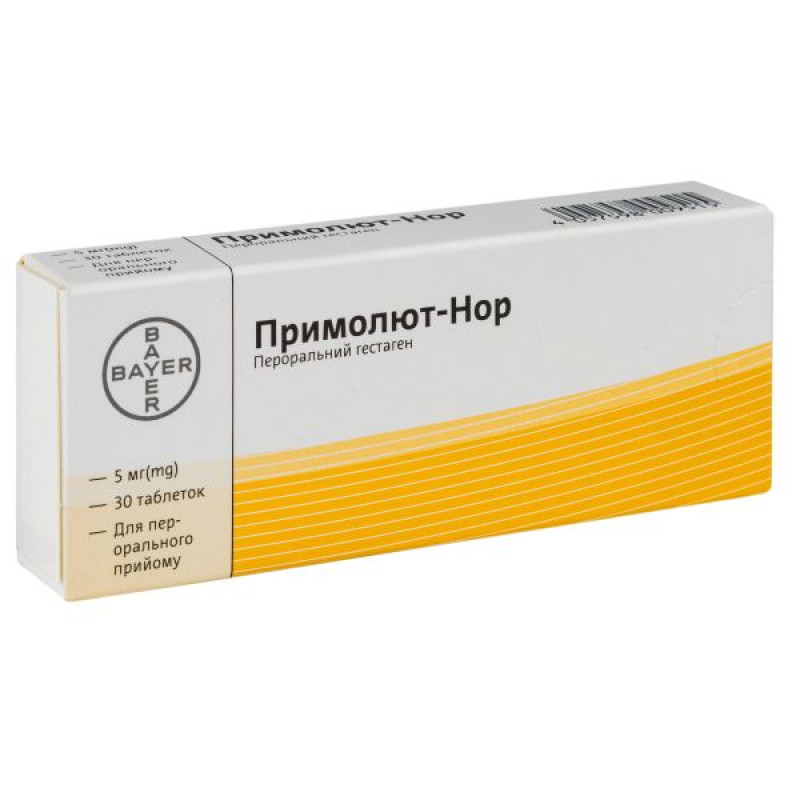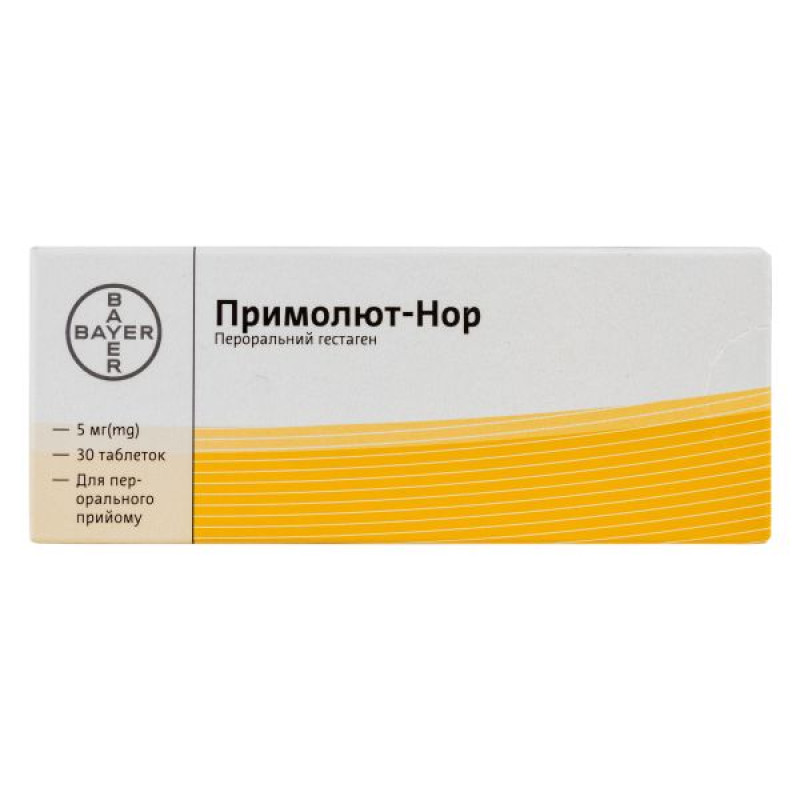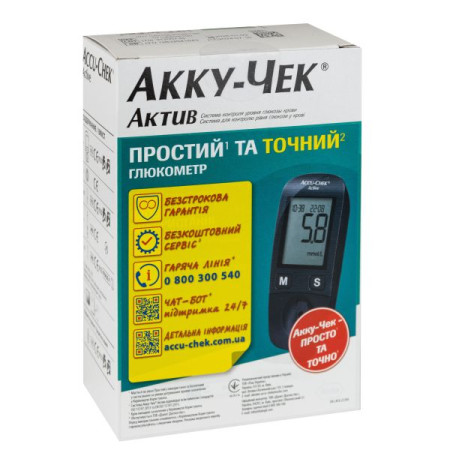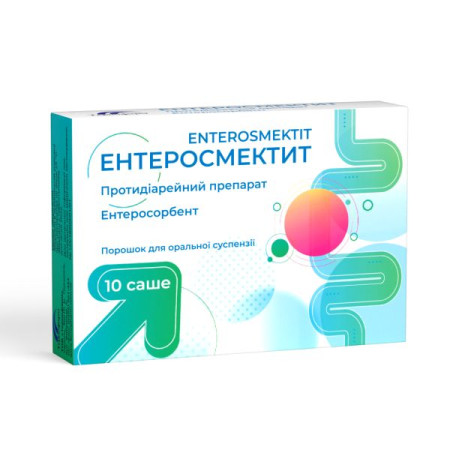Primolut-nor tablets 5 mg No. 30

Instructions for Primolut-nor tablets 5 mg No. 30
Composition
active ingredient: norethisterone acetate;
1 tablet contains: 5 mg of norethisterone acetate;
excipients: lactose monohydrate, corn starch, polyvidone 25000, talc, magnesium stearate.
Dosage form
Pills.
Main physicochemical properties: white tablets with a cross-shaped score on one side and “AR” in a regular hexagon on the other.
Pharmacotherapeutic group
Hormones of the sex glands and drugs used in pathologies of the genital area. Progestogens.
ATX code G03D C02.
Pharmacological properties
Pharmacodynamics
Norethisterone is a progestogen. In women sensitive to estrogens, a course of oral administration of 100–150 mg of norethisterone during one menstrual cycle can achieve a complete change in the endometrium, i.e. from a proliferative to a secretory state.
Gonadotropin secretion and anovulation are inhibited by daily administration of 0.5 mg of norethisterone acetate.
Norethisterone is a pyrogenic substance and affects basal body temperature.
Pharmacokinetics
Absorption
Norethisterone acetate is hydrolyzed during absorption and first pass through the liver to norethisterone, the active ingredient of the drug, and acetic acid. The highest concentration of norethisterone in the blood plasma is 18 ng/ml (after taking 5 mg of norethisterone acetate) and 25 ng/ml (after taking 10 mg of norethisterone acetate). These values are reached 2 hours after taking one tablet of Primolut-Nor. According to the study of relative bioavailability, the active ingredient is completely released from the tablet.
Distribution
Norethisterone is bound to plasma proteins and sex steroid binding globulin (SSGB). Only about 3–4% of the total plasma concentration of the active substance is found as free steroid, approximately 35% is bound to SSGB, and 61% is bound to albumin. The apparent volume of distribution of norethisterone is 4.4 ± 1.3 l/kg. After oral administration, the distribution of the active substance in plasma is biphasic. The plasma half-lives for the first and second phases are 1–3 hours and 5–13 hours, respectively.
Conditions for maintaining a stable state
With repeated daily administration of norethisterone, accumulation of this substance is unlikely due to its relatively short plasma half-life. However, if GSH-inducing drugs, such as ethinyl estradiol, are also taken daily, it is possible that the plasma concentration of norethisterone may increase due to its binding to GSH.
Metabolism
Norethisterone is metabolized primarily by saturation of the double bond of the A ring and shortening of the 3-keto group to a hydroxyl group, followed by conjugation with the corresponding sulfates and glucuronides. Some of the metabolites are eliminated from plasma extremely slowly, with a plasma half-life of about 67 hours. Therefore, during long-term treatment with daily oral administration of norethisterone, some of the metabolites accumulate in plasma.
Norethisterone is partially metabolized to ethinyl estradiol, meaning that for every milligram of norethisterone taken orally, an amount of ethinyl estradiol equivalent to a human oral dose of approximately 4–6 mcg is formed.
Breeding
Norethisterone is not excreted unchanged in significant quantities. Mostly metabolites with a shortened A-ring and hydroxylates, as well as their compounds (glucuronides and sulfates) are excreted in the urine and feces in a ratio of 7:3. Most of the metabolites excreted by the kidneys are excreted after about 24 hours, their half-life in blood plasma is about 19 hours.
Norethisterone passes into breast milk. The concentration of this substance in milk is about 10% of the maternal plasma levels, regardless of the route of administration. Considering that the average maximum level of the active substance in the maternal plasma is 16 ng/ml, and the daily feeding volume is about 600 ml of milk, a maximum of about 1 μg of this substance (0.02% of the maternal dose) can reach the child.
Indication
Secondary amenorrhea and endometriosis.
Contraindication
Primolut-Nor should not be used if you have any of the conditions or diseases listed below. If any of these develop during treatment with Primolut-Nor, the drug should be discontinued immediately.
Pregnancy or suspected pregnancy. Breastfeeding. Venous or arterial thrombotic/thromboembolic events (e.g. myocardial infarction, stroke, transient ischemic attack, deep vein thrombosis, pulmonary thromboembolism) present or history. Current or history of precursors of thrombosis (e.g. transient ischemic attack, angina pectoris).
Migraine with focal neurological symptoms in history. Diabetes mellitus with vascular complications. Severe liver disease, present or in the past, until liver function tests return to normal. Dubin-Johnson syndrome, Rotor syndrome, as well as jaundice or cases of severe skin itching during previous pregnancies. Previous cases of pemphigoid gestationis (herpes gestationis). Benign or malignant liver tumors, present or in the past. Malignant tumors that are dependent on the influence of sex hormones or suspected of their presence (for example, of the genital organs or breast). Hypersensitivity to norethisterone or to any of the excipients of the drug. History of idiopathic jaundice or severe itching during pregnancy. Vaginal bleeding of unknown etiology. Untreated endometrial hyperplasia.
Use of direct-acting antivirals containing ombitasvir, paritaprevir, or dasabuvir, or their combinations (see section “Interaction with other medicinal products and other types of interactions”).
Interaction with other medicinal products and other types of interactions
The effect of other medicines on Primolut-Nor
Interactions are possible with drugs that induce microsomal enzymes. This may lead to increased clearance of sex hormones, which in turn causes menstrual bleeding and/or loss of contraceptive efficacy.
Enzyme induction may be detected after a few days of treatment. Maximum enzyme induction is generally observed after a few weeks. After discontinuation of treatment, enzyme induction may persist for about 4 weeks.
Active substances that increase the clearance of sex hormones (reduced efficacy of COCs (combined oral contraceptives) due to enzyme induction), for example:
phenytoin, barbiturates, bosentan, primidone, carbamazepine, rifampicin, ritonavir, nevirapine and efavirenz, also possibly oxcarbazepine, topiramate, felbamate, griseofulvin and medicines containing St. John's wort extract.
Active substances with variable effects on sex hormone clearance
Concomitant use of COCs with many HIV/HCV protease inhibitors and non-nucleoside reverse transcriptase inhibitors may result in increased or decreased plasma concentrations of estrogens or progestogens. These changes may be clinically significant in some cases.
Active substances that reduce COC clearance (enzyme inhibitors)
The clinical significance of potential interactions with enzyme inhibitors is not yet known. Concomitant use of moderate or strong CYP3A4 inhibitors, such as azole antifungals (itraconazole, voriconazole, fluconazole), verapamil, macrolides (e.g. clarithromycin, erythromycin), diltiazem, and grapefruit juice, may result in increased plasma concentrations of estrogen or progestin or both. Etoricoxib at doses of 60 to 120 mg/day has been shown to increase plasma concentrations of ethinyl estradiol by 1.4- to 1.6-fold when co-administered with a combined oral contraceptive containing 0.035 mg ethinyl estradiol.
The effect of Primolut-Nor on other medicines
Progestogens may affect the metabolism of other drugs. Accordingly, plasma and tissue concentrations may increase (e.g., cyclosporine) or decrease (e.g., lamotrigine). Clinical data suggest that ethinylestradiol inhibits the clearance of CYP1A2 substrates, which in turn causes a slight (e.g., theophylline) or moderate (e.g., tizanidine) increase in their plasma concentrations.
Pharmacodynamic interactions
Concomitant use with medicinal products containing ombitasvir/paritaprevir/ritonavir and dasabuvir with or without ribavirin increases the risk of alanine aminotransferase (ALT) elevations (see sections 4.3 and 4.4). Primolut-Nor may be restarted 2 weeks after completion of therapy with this combination.
Other types of interaction
Laboratory tests: The use of progestogens may affect the results of certain laboratory tests.
Note: The prescribing information for concomitant medications should be consulted to identify potential interactions.
Application features
To prevent pregnancy, it is necessary to use non-hormonal methods of contraception (barrier).
Before initiating or continuing treatment with Primolut-Nor, an individual benefit/risk assessment should be performed if any of the disorders/risk factors described below are present or worsen.
Vascular disorders
Epidemiological studies have shown that oral ovulation inhibitors containing estrogens/progestogens are associated with an increased incidence of thromboembolic disorders. Therefore, the possibility of an increased risk of thromboembolism should be considered, especially in patients with a history of such conditions.
The increased risk of thromboembolism in the postpartum period should be taken into account.
Treatment should be discontinued immediately if symptoms of arterial or venous thrombosis occur or are suspected.
Patients with a history of VTE or a known thrombotic condition are at increased risk of developing VTE. Treatment with steroid hormones may increase this risk. Patients with a personal or family history of thromboembolism or recurrent spontaneous abortions should be examined to exclude a predisposition to thromboembolism. Patients receiving anticoagulant therapy should be carefully evaluated for thromboembolic risks before starting treatment with progestogens. In case of prolonged immobilization, elective surgery, especially in the abdominal area, or orthopedic surgery of the lower extremities, progestogen therapy should be discontinued 4–6 weeks before surgery. Continued treatment with progestogens is possible only after full recovery of the motor regime.
Tumors
Isolated cases of benign liver tumors and even rarer cases of malignant tumors have been described in patients taking hormonal substances that are part of the drug Primolut-Nor. In some cases, these tumors led to life-threatening intra-abdominal bleeding.
In women taking COCs, benign liver tumours and very rarely malignant liver tumours have been reported in isolated cases. In isolated cases, these tumours have led to life-threatening intra-abdominal haemorrhage. If women taking COCs develop severe upper abdominal pain, signs of liver enlargement or signs of intra-abdominal haemorrhage, a liver tumour should be considered.
Other states
Patients with diabetes should be under close medical supervision.
In rare cases, chloasma may occur, especially in women with a history of chloasma during pregnancy. Women prone to chloasma should avoid exposure to the sun or ultraviolet rays while taking Primolut-Nor.
In case of acute visual impairment, exophthalmos, diplopia, or migraine, optic disc edema or retinal damage should be ruled out.
Progestogens can cause fluid retention. Use with caution in patients with epilepsy, migraine, asthma, and cardiac dysfunction.
When using COCs, women with hypertriglyceridemia or a family history of it may have an increased risk of developing pancreatitis.
Patients with a history of depression should be closely monitored by their doctors. The drug should be discontinued if depression progresses.
Medical examination, examination and consultation with a doctor
Before starting or resuming treatment with Primolut-Nor, a complete medical history (including family history) should be taken, and the woman should undergo a complete medical examination, including a gynecological examination: contraindications (see section "Contraindications") and features of use (see section "Features of use") of the drug should be taken into account. The study should be repeated periodically during treatment with Primolut-Nor. The frequency and type of these studies depend on the individual characteristics of each individual woman, but they must necessarily include blood pressure measurement, examination of the mammary glands, abdominal cavity and pelvic organs, as well as cytological examination of the cervix.
Reasons for immediate discontinuation of treatment
Initial onset of severe headache and migraine or an increase in the frequency of unusually severe migraine, sudden disturbances of perception (e.g. visual or hearing disturbances), first signs of thrombophlebitis or symptoms of thromboembolism, feeling of pain and tightness in the chest, planned surgical interventions (6 weeks before surgery), immobilization, appearance of jaundice, development of hepatitis (non-icteric), generalized itching, significant increase in blood pressure, pregnancy.
Additional precautions based on the partial conversion of norethisterone to ethinyl estradiol
Norethisterone is partially metabolized to ethinyl estradiol, i.e., for each milligram of norethisterone/norethisterone acetate taken orally, an amount of ethinyl estradiol equivalent to an oral human dose of approximately 4–6 μg is formed.
Due to the partial conversion of norethisterone to ethinylestradiol, it is expected that the use of Primolut-Nor may cause pharmacological effects similar to those of combined oral contraceptives (COCs). Therefore, the following general precautions related to the use of COCs should be taken into account.
Vascular disorders
Epidemiological studies have shown that the incidence of VTE in patients taking low-estrogen-containing COCs (<50 μg ethinylestradiol) is approximately 20 to 40 cases per 100,000 women-years, but this risk estimate varies depending on the progestin. This compares with 5 to 10 cases per 100,000 women-years in those not taking oral contraceptives. The use of any COC is associated with an increased risk of VTE compared with non-use. This increased risk is less than the risk of VTE associated with pregnancy, which is estimated to be 60 cases per 100,000 pregnancies.
VTE can be life-threatening and may be fatal (in 1-2% of cases).
VTE, manifested by deep vein thrombosis and/or pulmonary embolism, can occur while taking any COC.
Thrombosis in other blood vessels, such as the arteries and veins of the liver, kidneys, mesenteric vessels, veins and arteries of the brain or retina, has been reported extremely rarely in women using COCs.
The use of COCs is associated with an increased risk of acute myocardial infarction (AMI) or stroke, which risk largely depends on the presence of other risk factors.
Common signs/symptoms of arterial or venous thrombotic/thromboembolic events or stroke may include:
severe pain in the calf area of one leg; swelling of the calf; sudden severe chest pain with possible irradiation to the left arm; sudden shortness of breath; sudden coughing attack; any unusual, severe and prolonged headache; sudden partial or complete loss of vision; double vision; slurred speech or aphasia; dizziness; collapse with or without focal epilepsy; weakness or sudden numbness of one side or part of the body; movement disorders; acute abdomen.
The possible synergistic increase in the risk of thrombosis should be considered in women with a combination/combination of several risk factors or a single serious risk factor. The increase in risk may be greater than the sum of the risks associated with each individual factor. If the benefit/risk ratio is unfavorable, COCs should not be prescribed (see section "Contraindications").
The risk of developing venous or arterial thrombotic/thromboembolic events or stroke increases with the presence of the following factors:
age; obesity (body mass index > 30 kg/m2); relevant family history (i.e., a relative with a history of venous or arterial thromboembolism at a relatively early age in a sibling or parent). If a hereditary predisposition is suspected, the woman should be referred to an appropriate specialist for advice before deciding whether to use COCs; prolonged immobilization, major surgery, any surgery on the lower extremities, or extensive trauma. In these situations, it is advisable to stop using COCs (in the case of elective surgery at least 4 weeks before the procedure) and not to resume taking the drug until remobilization; smoking (the risk increases with heavy smoking and with age, especially in women over 35 years of age); dyslipoproteinemia; arterial hypertension; migraine (an increase in the frequency and severity of migraines during COC use may be a prodromal event of cerebrovascular accident and is therefore a reason for immediate discontinuation of COCs); heart valve pathology; atrial fibrillation.
There is no consensus on the possible impact of varicose veins and superficial thrombophlebitis on the development of VTE.
Other conditions that have been associated with adverse effects on the circulatory system include: diabetes mellitus, systemic lupus erythematosus, hemolytic uremic syndrome, chronic inflammatory bowel diseases (Crohn's disease and ulcerative colitis), and sickle cell anemia.
An increase in the frequency or severity of migraine during COC use may be a prodromal event of cerebrovascular accident and, therefore, is a reason for immediate discontinuation of COC use.
Biochemical factors that may indicate a hereditary or acquired predisposition to venous or arterial thrombosis include: resistance to activated protein C (APC), hyperhomocysteinemia, antithrombin III deficiency, protein C deficiency, protein S deficiency, antiphospholipid antibodies (anticardiolipin antibodies, lupus anticoagulant).
When assessing the benefit/risk ratio of the drug, the physician should remember that appropriate patient management can reduce the relative risk of thrombosis and that the risk of VTE associated with pregnancy is higher than the risk associated with the use of low-dose COCs (<0.05 mg ethinylestradiol).
Oncological diseases
A meta-analysis of 54 epidemiological studies has shown a small increased relative risk (RR = 1.24) of breast cancer in women who use COCs. This increased risk gradually disappears within 10 years after stopping COCs. Since breast cancer is rare in women under 40 years of age, the increase in breast cancer in women who are current or recent users of COCs is small compared with the overall risk of breast cancer. The results of these studies do not provide evidence of a causal relationship. The observed increased risk may be due to earlier diagnosis of breast cancer in women who use COCs, to the biological effects of COCs, or to a combination of both. It has been noted that breast cancer found in women who have ever used COCs is usually clinically less severe than in women who have never used COCs.
Neoplasms can be life-threatening or fatal.
Other states
Although a slight increase in blood pressure has been reported in many women taking COCs, clinically significant increases are rare. However, if persistent clinically significant hypertension develops during COC use, the physician should discontinue COCs and initiate treatment for the hypertension. If blood pressure returns to normal after antihypertensive therapy, COC use may be resumed if deemed appropriate.
The following conditions have been reported to occur or worsen during pregnancy and with COC use, but the association with COC use is not conclusively proven: jaundice and/or pruritus associated with cholestasis; gallstone formation; porphyria; systemic lupus erythematosus; haemolytic uraemic syndrome; Sydenham's chorea; herpes gestationis; hearing loss associated with otosclerosis.
In women with hereditary angioedema, exogenous estrogens may induce or exacerbate symptoms of the disease.
Acute or chronic liver dysfunction may require discontinuation of COC use until liver function tests return to normal. Recurrence of cholestatic jaundice, first occurring during pregnancy or previous use of sex steroids, requires discontinuation of COC use. Crohn's disease and ulcerative colitis have been associated with COC use.
Impact on laboratory test results
Taking progestogens may affect the results of some laboratory tests.
Elevated ALT levels
In clinical trials in patients treated for hepatitis C with the medicinal products containing ombitasvir/paritaprevir/ritonavir and dasabuvir with or without ribavirin, transaminase (ALT) elevations greater than 5 times the upper limit of normal (ULN) were observed significantly more frequently in women using medicinal products containing ethinylestradiol, such as combined hormonal contraceptives (CHCs). Since norethisterone is partially metabolised to ethinylestradiol, this warning applies to women taking norethisterone (see sections 4.3 and 4.5).
Warnings regarding excipients
This medicinal product contains lactose. Patients with rare hereditary problems of galactose intolerance, the Lapp lactase deficiency or glucose-galactose malabsorption should not take this medicinal product.
Ability to influence reaction speed when driving vehicles or other mechanisms
Unknown.
Use during pregnancy or breastfeeding
The use of the drug Primolut-Nor is contraindicated in women during pregnancy and breastfeeding (see the section "Contraindications").
Method of administration and doses
To prevent pregnancy, it is necessary to use non-hormonal methods of contraception (barrier).
Dosage
Secondary amenorrhea
Hormonal treatment of secondary amenorrhea can only be carried out after pregnancy has been ruled out.
Before starting treatment for secondary amenorrhea, the presence of a prolactin-secreting pituitary tumor should be ruled out. It cannot be ruled out that macroadenomas increase in size under the influence of high doses of estrogens over a long period of time.
Before starting Primolut-Nor, the endometrium must be prepared with estrogen (for example, for 14 days). After that, 1–2 tablets of Primolut-Nor are taken daily for 10 days. Withdrawal bleeding begins a few days after taking the last tablet.
When sufficient estrogen production by the body is achieved, an attempt can be made to stop estrogen treatment and induce cyclic bleeding by taking 1 tablet of the drug Primolut-Nor 2 times a day from the 16th to the 25th day of the cycle.
Endometriosis
1 tablet 2 times a day. In case of spotting, it is necessary to increase the dose and take 2 tablets of Primolyut-Nor 2 times a day. After the bleeding stops, the dose can be reduced to the initial one. The duration of the treatment course is at least 4–6 months. With continuous daily use of the drug, ovulation and menstruation are usually absent.Method of application
The tablets are taken with a small amount of liquid and without chewing.
Children
The drug should not be used in children.
Overdose
Acute toxicity studies have not demonstrated a risk of acute adverse reactions in the event of accidental ingestion of the drug at a dose several times higher than the daily therapeutic dose.
Adverse reactions
Side effects are most often observed in the first months of taking Primolut-Nor. Over time, their number decreases. The following are described side effects in patients who took Primolut-Nor. However, a cause-and-effect relationship cannot always be confirmed.
The table below lists adverse reactions by System Organ Class (MedDRA SOCs). Adverse reactions are presented in order of decreasing seriousness within each indication. The frequency of adverse reactions is based on post-marketing experience and literature data.
| System Organ Class | Very common (≥1/10) | Common (≥1/100, <1/10) | Uncommon (≥1/1000, <1/100) | Single (≥1/10000, <1/1000) | Rare (<1/10000) |
| On the part of the immune system | Hypersensitivity reactions | ||||
| From the nervous system | Headache | Migraine | |||
| From the organs of vision | Vision impairment | ||||
| Respiratory, mediastinal and thoracic disorders | Dyspnea | ||||
| Gastrointestinal tract | Nausea | ||||
| Skin and subcutaneous tissue disorders | Hives, rash | ||||
| Reproductive system and breast disorders | Uterine/vaginal bleeding, including spotting*. Light menstruation (hypomenorrhea*) | Amenorrhea* | |||
| General condition disorder | Edema |
*With endometriosis.
The corresponding MedDRA terms were used to describe a specific reaction, its symptoms and associated disorders.
Frequency not known (cannot be estimated from the available data) (see details in the section "Features of use"):
thromboembolism, liver tumors leading to intra-abdominal bleeding, chloasma, severe headache and migraine or an increase in the frequency of unusually severe migraines; sudden disturbances of perception; the first signs of thrombophlebitis or symptoms of thromboembolism; a feeling of pain and tightness in the chest; the appearance of jaundice, the development of hepatitis, itching of the skin, a significant increase in blood pressure.
Dizziness, increased depression, abdominal pain, and cholestasis were also observed.
Very high doses of Primolut-Nor may in some cases lead to cholestatic liver disorders.
Reporting of suspected adverse reactions
Reporting of suspected adverse reactions during post-marketing surveillance is very important. This allows monitoring of the benefit/risk balance of the medicinal product. Healthcare professionals should report suspected adverse reactions.
Expiration date
5 years.
Storage conditions
Store at a temperature not exceeding 30 ºС in a place inaccessible to children.
Packaging
15 tablets in a blister; 2 blisters in a cardboard pack.
Vacation category
According to the recipe.
Producer
Bayer Weimar GmbH & Co. KG.
Location of the manufacturer and its business address
Dobereinerstrasse 20, 99427 Weimar, Germany.
There are no reviews for this product.
There are no reviews for this product, be the first to leave your review.
No questions about this product, be the first and ask your question.


















